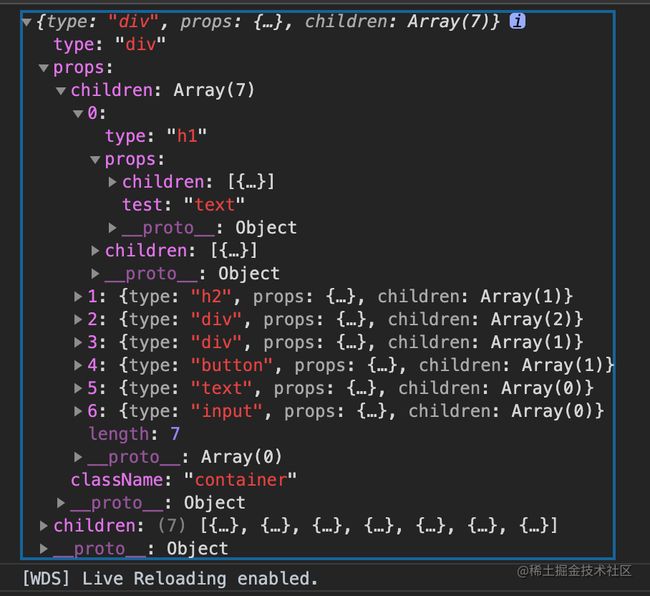React原理(一)VirtualDom 到渲染UI
VirtualDom介绍
virtualDom实际就是个object类型的字典{},字典中包含type,props,children,textContent等key来描述的是dom元素的。
如下所示真是的dom
React
描述dom的VirtualDom,则为
{type: "div",props: { className: "container" },children: [{type: "div",props: null,children: [{type: "text",props: {textContent: "React"}}]}]
}
VirtualDom生成过程
我们可以先看babel在线转换
{funcDoc}
function fucDoc() {return function component
}
可以看到上述代码经过babel转换后会调用React.createElement api
"use strict";
/*#__PURE__*/
React.createElement("div", {name: "33"
}, /*#__PURE__*/React.createElement("div", null, funcDoc));
function fucDoc() {return /*#__PURE__*/React.createElement("div", null, "function component");
}
而调用React.createElement 的api后返回的刚好是我们想要的VirtualDOm 如下代码所示返回的刚好是VirtualDOm对象。
/**
*
* @param type 标签类型
* @param props 标签的属性
* @param children子元素
* @returns {{children: *[], type, props}}
*/
export default function createElement (type, props, ...children) { const childElements = ...省略处理逻辑...return {type,props,childElements}
}
实现tinyReact
环境配置
统一配置
我们需要告诉babel使用我们自己写的TinyReact,需要配置babel
在.babelrc文件中将React改为TinyReact
{"presets": ["@babel/preset-env",["@babel/preset-react",{"pragma": "TinyReact.createElement" //React改为TinyReact}]]
}
通过以上配置告诉babel调用TinyReact.createElement来转换jsx文件
单个文件配置
除了统一配置外也可以在单个文件中添加 /** @jsx TinyReact.createElement */注释,来实现单个文件配置

生成VirtualDom
上一步操作会让babel调用我们自己写的createElement方法
//index.js文件
const virtualDOM = (我是标题一
我是标题二
div嵌套一下 里面的div{shouldHide && 条件渲染1}{!shouldHide && 隐藏我}2, 3
)
console.log(virtualDOM)
如果createElement直接返回打印结果如下

可以看到文本被放在children中直接返回了,显然不对的,另外条件渲染!shouldHide为false被直接返回了,我们想要的是隐藏标签的效果
文本节点对应virtualDom为
{type: 'text',props: {textContent: '我是文本'}
}
/**
*
* @param type 标签类型
* @param props 标签的属性
* @param children子元素
* @returns {{children: *[], type, props}}
*/
export default function createElement (type, props, ...children) {const childElements = [].concat(...children).reduce((result,child) => {if (child !== false && child !== true && child !== null) {if (child instanceof Object) {result.push(child)} else {// 文本节点 手动调用 createElementresult.push(createElement("text", {textContent: child}))}} return result}, [])return {type,props: Object.assign({ children: childElements }, props),children: childElements}
}

实现render方法渲染UI
//index.js
......
TinyReact.render(//TinyReact/index.js
import createElement from "./createElement";
import render from "./render";
export default {render,createElement
}
//TinyReact/render.js
import mountElement from "./mountElement";
export default function render(virtualDOM, container, oldDom) {mountElement(virtualDOM, container)
}
//TinyReact/mountElement
import {isFunction} from "./utils";
import mountComponent from "./mountComponent";
import mountNativeElement from "./mountNativeElement";
export default function mountElement(virtualDOM, container) {if (isFunction(virtualDOM)) {// 判断是否为组件,组件的逻辑稍后实现 // mountComponent(virtualDOM, container, oldDOM)} else {mountNativeElement(virtualDOM, container, oldDOM)}
}
//TinyReact/mountNativeElement
import createDOMElement from "./createDOMElement"
export default function mountNativeElement(virtualDOM, container) {const newElement = createDOMElement(virtualDOM)container.appendChild(newElement)
}
//TinyReact/createDOMElement
export default function updateElementNode(element, virtualDOM) {const newProps = virtualDOM.propsObject.keys(newProps).forEach(propName => {const newPropsValue = newProps[propName]if (propName.slice(0, 2) === "on") {const eventName = propName.toLowerCase().slice(2)element.addEventListener(eventName, newPropsValue)} else if (propName === "value" || propName === "checked") {element[propName] = newPropsValue} else if (propName !== "children") {if (propName === "className") {element.setAttribute("class", newPropsValue)} else {element.setAttribute(propName, newPropsValue)}}})
}